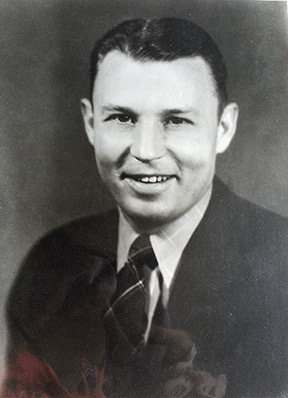Paul E. Pearson
Paul Pearson was born in Concordia, Kansas in 1906. In the years before the war Paul attended Kansas State University, got married, had two kids, and worked as a pharmacist at the Rexall Drug Store on Poyntz Avenue in Manhattan. As the clouds of war gathered in 1941, however, the 35-year-old married father of two joined the United States Army.
Paul was stationed in the Philippines as a staff officer for MacArthur’s II Philippine Corps when the Japanese struck in December 1941. Though outnumbered, outgunned, and far from help, the American and Filipino defenders fought courageously for months until they were finally overcome by Japanese forces in April 1942. It was then that Paul and tens of thousands of his comrades were forced to endure hellish treatment at the hands of their Japanese captors.
60,000-80,000 American and Filipino troops were forced at gunpoint to march over sixty miles to their internment in Japanese prisoner of war camps. Along the way the Japanese subjected the starving Allied troops to brutal beatings, executions, and torture in what has become known as the “Bataan Death March.” Untold thousands of prisoners died from their treatment before ever reaching the camps.
Captain Pearson survived the Death March but his trials were far from over. Over the next three years Paul was forced to endure brutal treatment as he was transferred from one prisoner of war camp to another. Details are scarce, but it seems Paul spent much of his time at the infamous Japanese prisoner of war camp at Cabanatuan in the Philippines before plans were made to transfer him to a facility in Japan itself.
Unfortunately, Paul never made it to Japan. In late December 1944 he was among the thousands of Allied prisoners placed on ships bound for Japan ahead of the Allied invasion of the Philippines. Paul was packed with hundreds of others onto the Japanese “hell ship” Enoura Maru. Hell ships were infamous for their deplorable, filthy conditions and the starving prisoners on board.
On January 9, 1945 Allied bombers targeted the unmarked Japanese transport convoy carrying the Allied prisoners. Bombs struck the Enoura Maru off the waters of Formosa, penetrating the ship’s decks and exploding in the hull where the tightly-packed prisoners were being held. Approximately 400 Allied prisoners of war were killed in the explosion and its aftermath. Unfortunately, Captain Paul Pearson was among them.
Paul’s remains were repatriated to the United States after the war. He has a grave marker in Arlington National Cemetery and his remains are buried in the National Cemetery of the Pacific in Hawaii.


